Used coffee grounds can actually give your houseplants a helpful little boost, especially lush pothos varieties, peace lilies, and bushy spider plants with striped leaves but only when used the right way. When applied properly, they can add nitrogen, improve soil texture, and support healthy growth. But too much? That’s where trouble starts, think soggy soil, mold, or stressed-out roots. Not good!
In this post, I’ll break down which indoor plants actually like coffee grounds (yep, some are totally into it) and exactly how to use them without turning your pots into a science experiment.
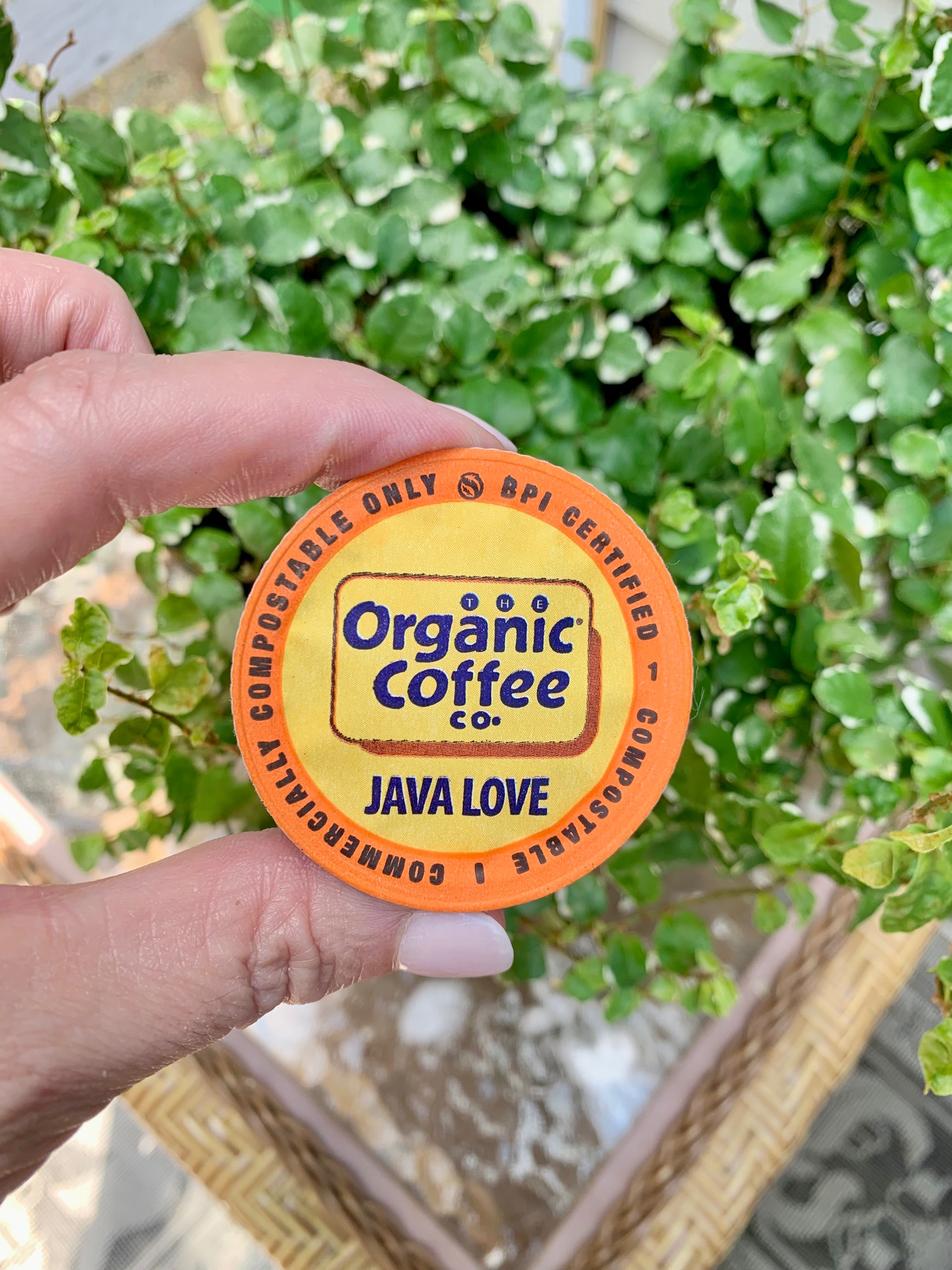
*This post includes affiliate links, for more info on affiliate links visit here
Jump to:
- Are coffee grounds good for indoor plants?
- Which indoor plants benefit from coffee grounds?
- Which indoor plants don’t like coffee grounds?
- What type of coffee grounds are best for indoor plants
- 3 safe ways to use coffee grounds for indoor plants
- Frequently asked questions
- How to make coffee tea fertilizer with a K-Cup
- More indoor plant care posts you’ll love!
Are coffee grounds good for indoor plants?
Yes, used properly, coffee grounds can benefit some indoor plants by improving soil texture and boosting nitrogen levels. Nitrogen supports healthy root development, vibrant leaves, and in some cases, better blooms [NIH:Nitrogen Journey in Plants: From Uptake to Metabolism, Stress Response, and Microbe Interaction]. Most people assume used grounds are close to pH neutral (around 6.5–6.8)[Gardening Know How: Give Compost A Pick Me Up: How To Use Coffee Grounds On Plants In The Garden], making them suitable for occasional use in houseplant care.
I recently tried coffee grounds with a few blooming African violets after their flowers dropped prematurely. Since African violets need nitrogen to support lush foliage and stem development, they seemed like the perfect test plant. Fingers crossed, I’m hopeful the added boost will bring those bright blooms back soon.

Which indoor plants benefit from coffee grounds?
Several indoor plants thrive with small amounts of coffee ground compost or diluted coffee fertilizer, especially those that prefer slightly acidic, nitrogen-rich soil. Below is a list of houseplants that may benefit from used coffee grounds when applied properly.
| Plant Name | Likes Coffee Grounds? | Tips |
|---|---|---|
| African Violet | ✅ Yes | Use sparingly, avoid wet grounds |
| Peace Lily | ✅ Yes | Mix into compost monthly |
| Pothos | ✅ Yes | Try in coffee “tea,” not raw |
| Philodendron | ✅ Yes | Use diluted mix during growing season |
| Azalea | ✅ Yes | Likes acidity; composted grounds preferred |
| Christmas Cactus | ✅ Yes | Infrequent use; boost during bloom prep |
| Cyclamen | ✅ Yes | Use after dormancy to encourage blooming |
| Miniature Roses | ✅ Yes | Add to compost; keep soil well-drained |
| Jade Plant | ⚠️ Limited | Only in compost — direct use can hold moisture |
| Snake Plant | ⚠️ Limited | Sensitive roots; composted only |
| Spider Plant | ✅ Yes | Light top-dressing or mixed into potting mix |
Note: Even coffee-friendly plants can suffer from overuse. Always start small and watch for signs of stress like yellowing leaves or slowed growth.
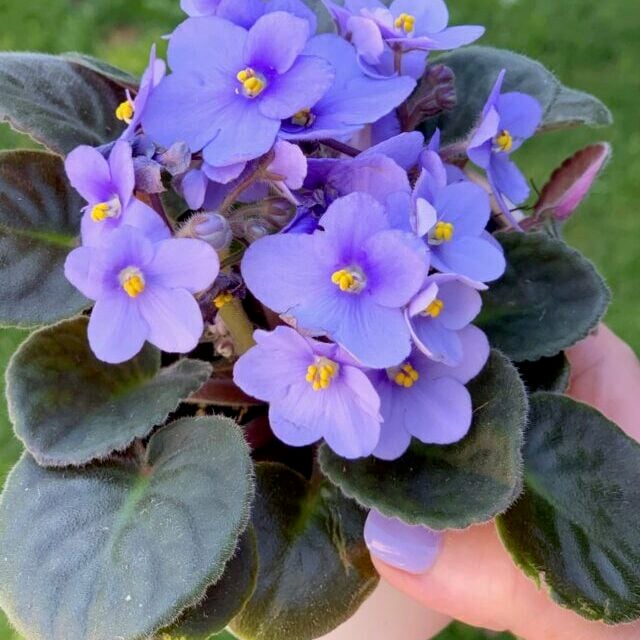

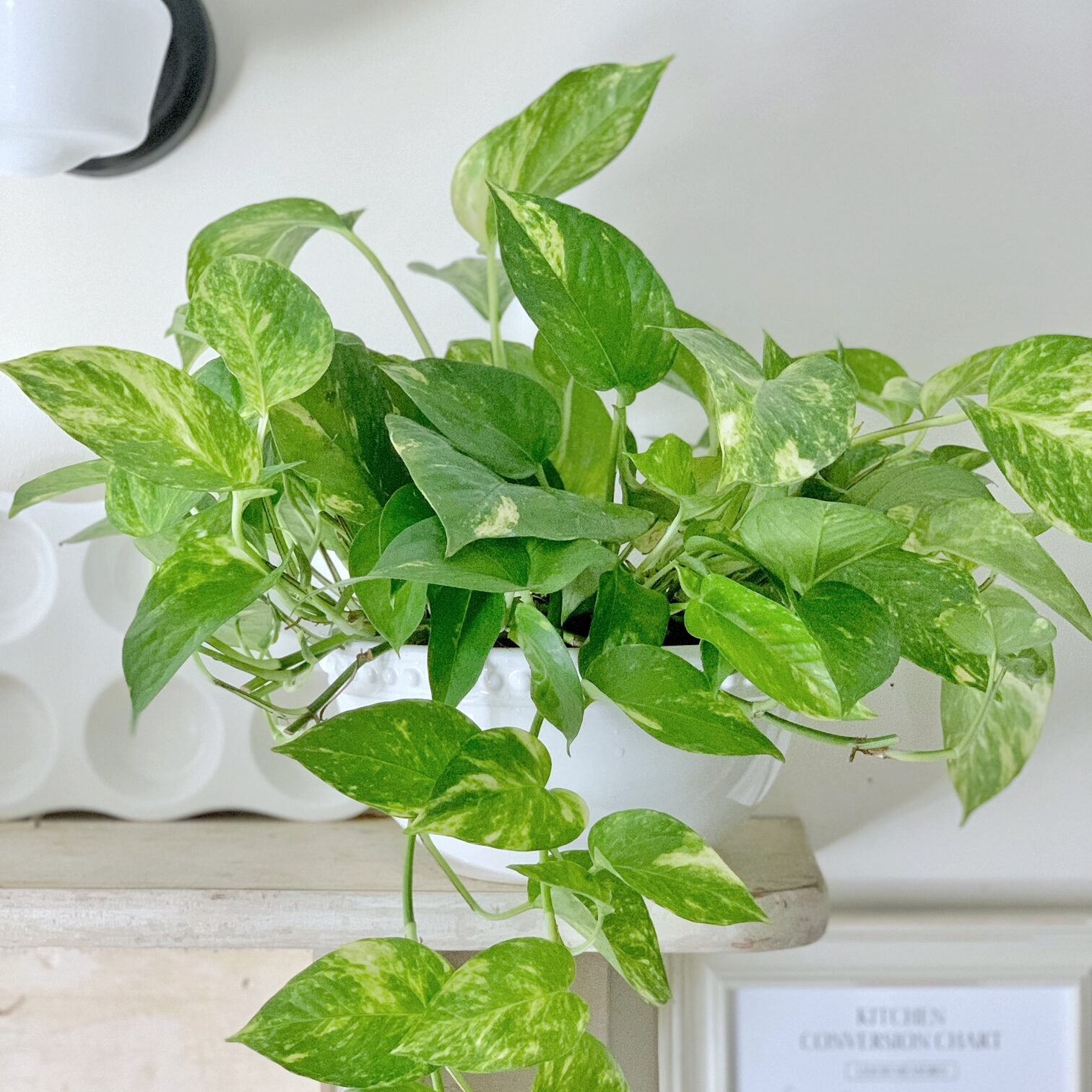

More indoor plants that like coffee grounds
While only a few favorites are pictured above, many indoor plants enjoy the slow-release nutrients coffee grounds can offer, especially when composted or diluted into a “coffee tea.” Below, you’ll find a list of houseplants that may benefit from occasional use of coffee-based fertilizer, along with tips based on my own care experience.
African Violets
These nitrogen-loving, fuzzy-leafed beauties love acidic soil, making coffee grounds a smart match. I’m currently testing this on my own plants and hoping it encourages more African violet blooms!
Peace lily
Peace lilies enjoy slightly acidic, nutrient-rich soil. I’ve found that adding composted coffee grounds in small amounts improves foliage health, but too much can make the soil soggy.
Pothos and Golden Pothos
One of the easiest houseplants to grow! While pothos aren’t heavy feeders, mine responded well to a diluted coffee water treatment once a month. Always flush with water after. They do well in bright light, indirect light, as well as low light and, are quite easy to propagate. A very tolerant choice for sure!
Philodendron
Philodendrons thrive in bright, indirect light, but they also do surprisingly well in low-light spaces, which makes them a versatile favorite in my home. They appreciate a mild nitrogen boost, so I like to sprinkle dried, used coffee grounds into their potting mix once a month (just not too close to the stem).
Azalea
These flowering favorites love acidic soil, so coffee grounds are a perfect companion. I use mine as mulch or mix them into compost to encourage brighter blooms.
Christmas cactus
These bloomers prefer light feedings. A small amount of coffee water during active growth seems to give mine a nice perk without overwhelming their sensitive roots.
Cyclamen
Only feed cyclamen with coffee tea when actively growing, never during dormancy. I’ve noticed deeper flower color when using it once a month.
Miniature Roses
These compact roses respond well to nutrient-rich soil. I use coffee grounds in compost or tea form, and they reward me with more buds and brighter leaves.
Jade Plants
As a succulent, jade doesn’t want wet soil, but a sprinkle of dry, used grounds blended into the potting mix adds minerals without moisture.
Snake Plant
This plant thrives on neglect but appreciates a mild nitrogen boost. I’ve added used grounds into the soil base when repotting, with good results.
Spider Plant
Spider plants are fast growers. I’ve used coffee tea occasionally, and it seems to support baby “spiderettes” and fuller leaf growth.
Which indoor plants don’t like coffee grounds?
While many houseplants benefit from used coffee grounds, not all do. Succulents like aloe and some cacti dislike excess moisture, and the added acidity can throw off their preferred soil balance. Ferns like maiden hair ferns, orchids, and carnivorous plants may also react poorly to coffee—either because of sensitive root systems or their unique nutrient needs.
If you’re unsure, it’s best to skip coffee grounds or use only fully composted grounds in very small amounts. Watch for signs of stress like wilting, yellow leaves, or slowed growth.
What type of coffee grounds are best for indoor plants
If you're wondering which coffee grounds are safe and beneficial for houseplants, the answer is simple: use unflavored, brewed coffee grounds, either regular or decaf. Avoid flavored varieties or grounds with added sugar or creamer.
For best results:
- Use grounds from black coffee only (no added oils, syrups, or dairy).
- Allow coffee grounds to dry completely before using to avoid mold.
- Consider composting them first for a gentler, slow-release effect.
As a daily coffee drinker, I use compostable pods from Organic Coffee Co. (available on Amazon). They're organic, pesticide-free, and made with plant-based materials. It felt wasteful to toss them and now my plants get to enjoy the leftovers!

3 safe ways to use coffee grounds for indoor plants
Before you start, it’s important to know what not to do: avoid pouring coffee directly onto your plants or dumping fresh grounds into pots. While coffee contains nutrients, too much can oversaturate the soil, introduce fungal problems, and even stunt plant growth due to excess caffeine.
Instead, try one of these three gentle methods that make the most of coffee’s benefits:
1. Make compost with coffee grounds
Composting is one of the safest ways to reuse coffee grounds. Coffee adds nitrogen-rich green matter to your compost pile. Balance it with brown materials like dry leaves or shredded paper. Once it breaks down, the compost improves the structure and nutrient content of your potting soil. I recommend a 1:4 compost-to-soil ratio when adding it to your indoor plants.
2. Mix coffee grounds into potting soil
When repotting, stir a small amount of used, dried coffee grounds directly into your potting mix. A good ratio is one part coffee grounds to three parts potting soil. This encourages the growth of beneficial microbes and boosts nitrogen levels, especially for flowering plants that benefit from richer soil.
3. Make coffee tea fertilizer
Coffee tea is a diluted liquid fertilizer made from used grounds. Mix two cups of brewed coffee grounds with five gallons of water and let it steep for 48 to 72 hours, stirring occasionally. Strain out the solids, then use the liquid to water your plants or apply it as a foliar spray. Avoid spraying plants like African violets that don’t tolerate moisture on their leaves. See Step-by-step instructions below.
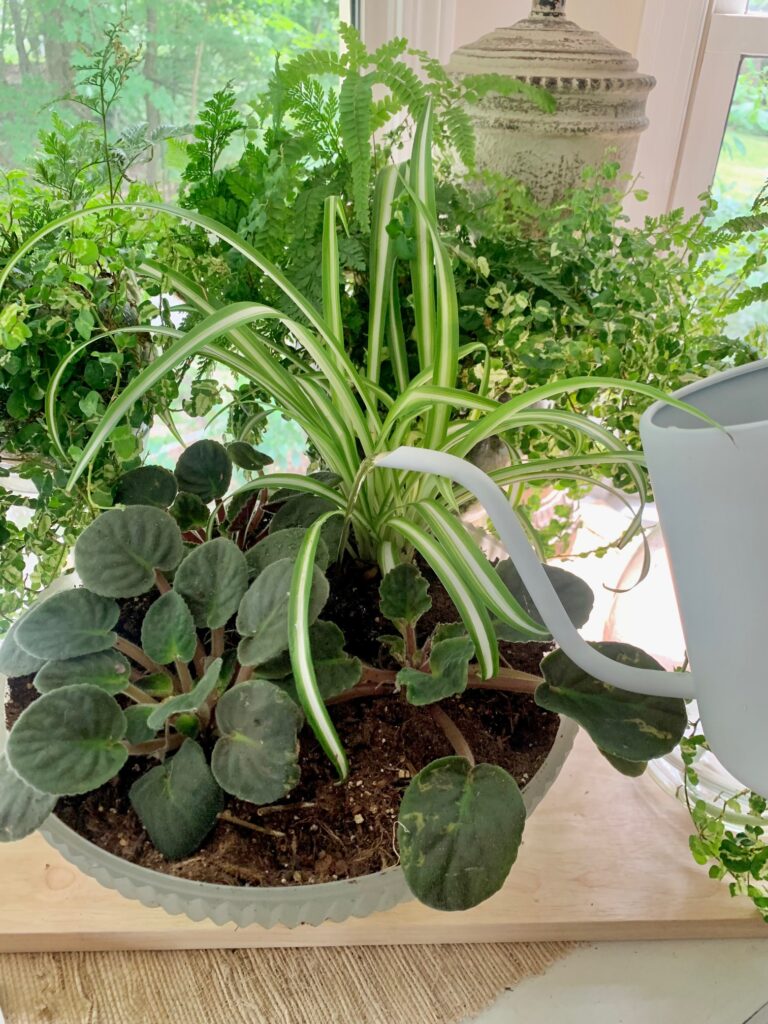
Frequently asked questions
It’s not recommended to use fresh or wet coffee grounds directly on your houseplants. Doing so can compact the soil, retain too much moisture, and introduce mold or fungus. Always compost them first or dilute into “coffee tea” for safest use.
Plants that enjoy slightly acidic, nitrogen-rich soil tend to respond best. This includes African violets, peace lilies, pothos, philodendrons, spider plants, and miniature roses. Use composted grounds or diluted coffee water sparingly.
Start once a month and observe how your plant responds. For compost or potting mix blends, less is more. For coffee tea, once every 3–4 weeks is typically safe. Watch for yellowing leaves or slowed growth as signs of overuse.
Yes, but only in small amounts and mixed into the potting mix not layered on top. In self-watering systems, excess moisture can build up, and coffee grounds retain water. Always ensure good drainage.
Brewed black coffee can be used in small, diluted amounts but never hot or freshly brewed. Mix with water at a ratio of 1:4 (coffee to water) and use sparingly. Avoid sugary or flavored varieties entirely.
Yes! Decaf grounds offer many of the same soil benefits without the added caffeine, which some plants may be sensitive to. They’re a great option for cautious gardeners.
How to make coffee tea fertilizer with a K-Cup
Use leftover coffee grounds to boost your indoor plants naturally.
Supplies
- Keurig Coffee Maker
- 1 K-Cup or coffee pod (2 Tablespoons of grounds. Regular or decaf - avoid flavored coffee)
- 6 cups of cool water
- Fine mesh strainer
- Jar or pitcher that holds 6 Cups of water
- Watering Can
Step-by-step instructions

- Step 1: Using a Keurig or other single serve coffee maker and a coffee pod or K-Cup - brew a cup of coffee. (enjoy the coffee as you normally would)
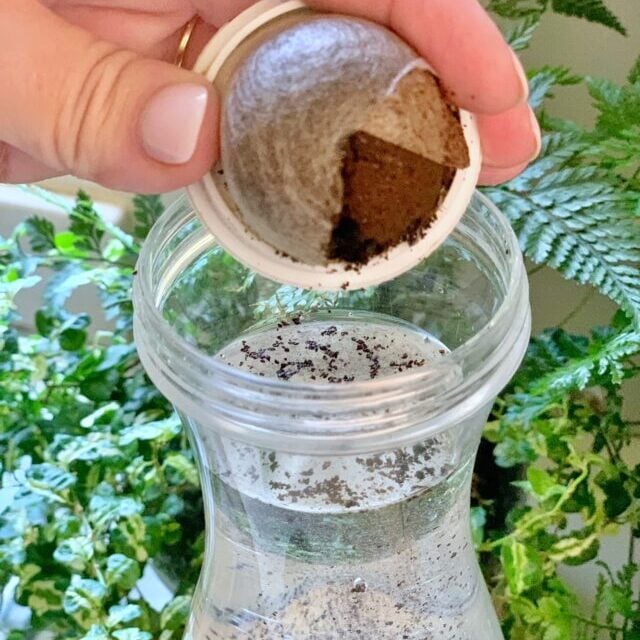
- Step 2: Open cooled K-Cup container and empty the coffee grounds into a pitcher of 6 cups of cool water. (2 Tablespoons of Coffee grounds : 6 cups water is the coffee grounds water ratio.)
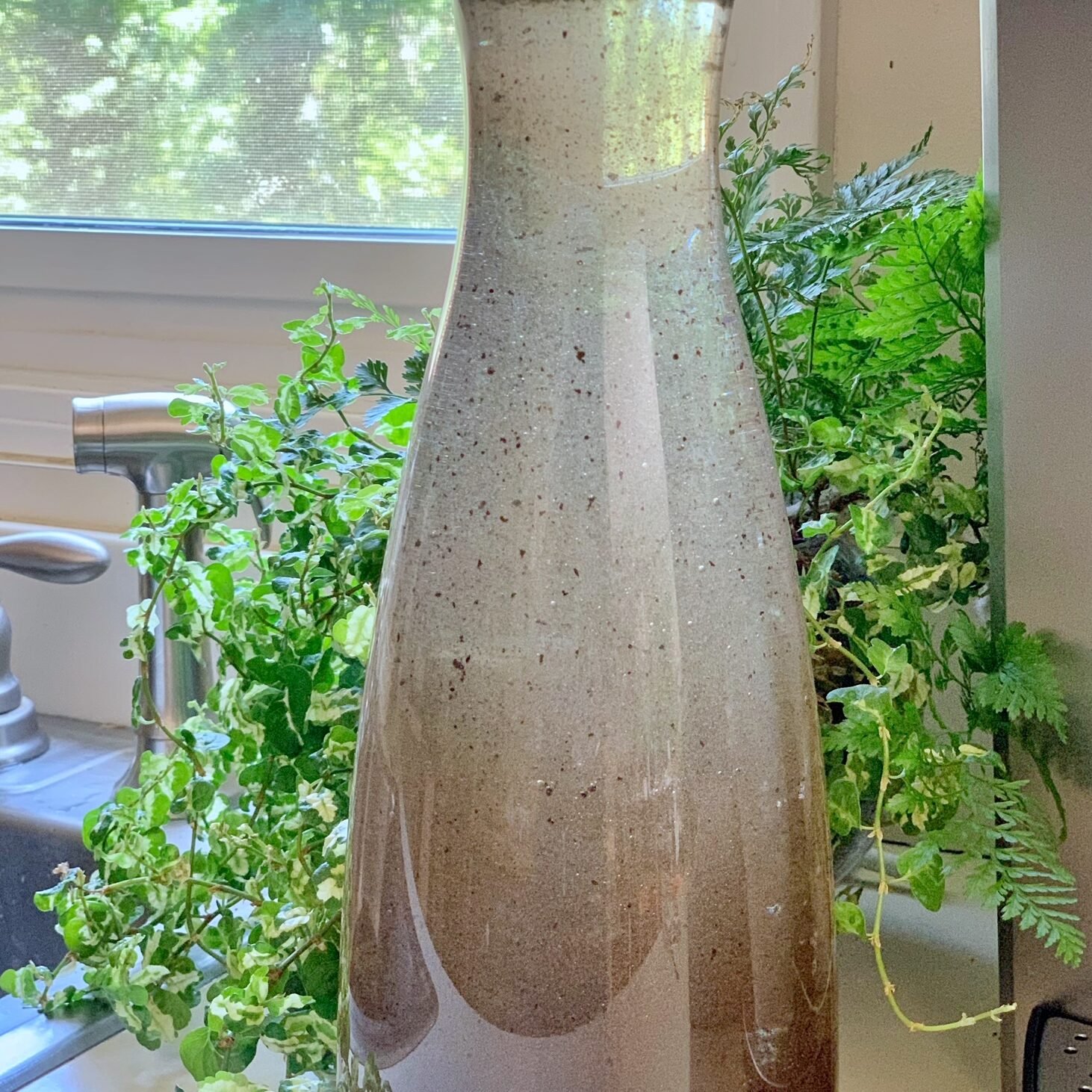
- Step 3: Let the coffee grounds and water mixture sit for 72 hours. Shake occasionally.
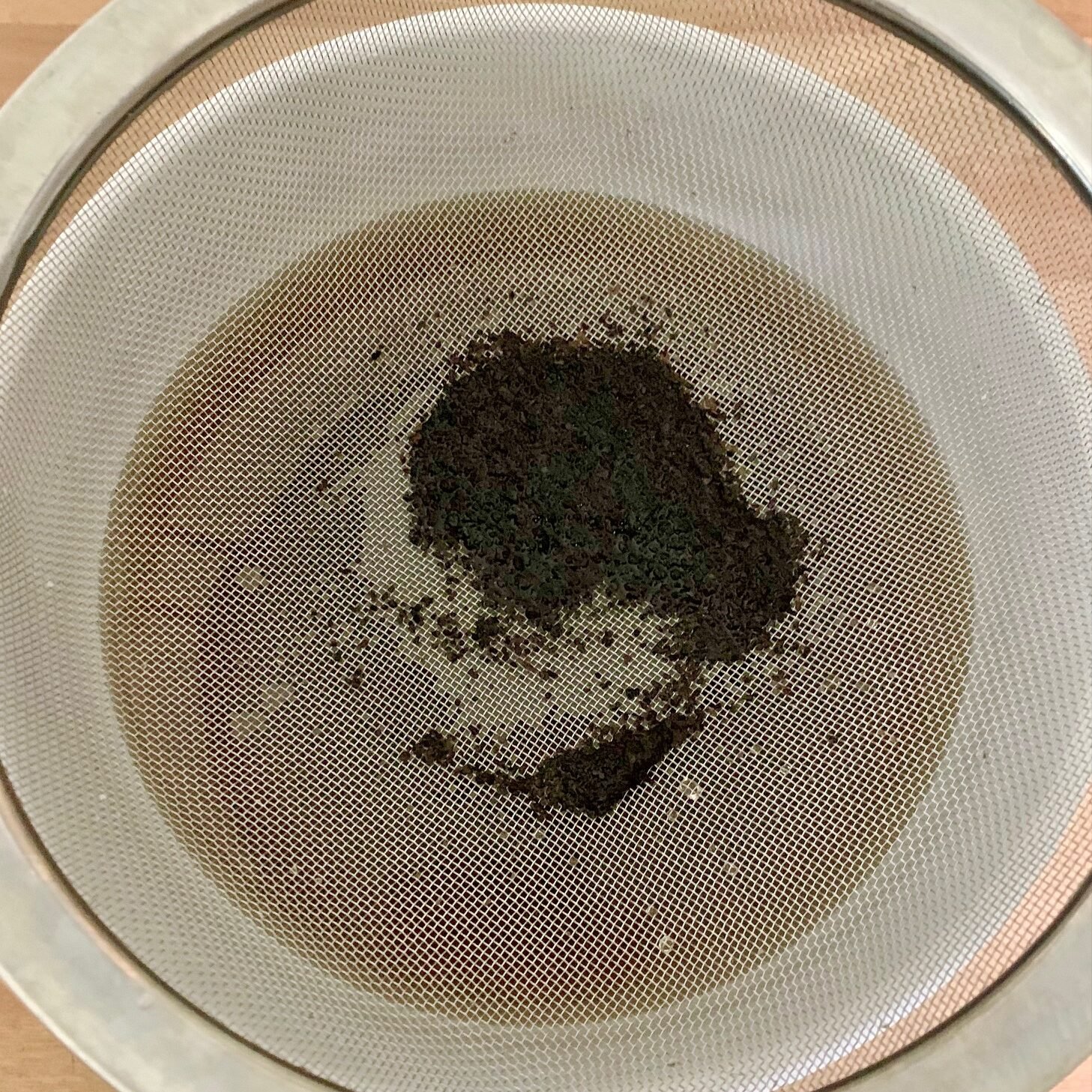
- Step 4: Strain the grounds leaving just the diluted coffee mixture. Discard the coffee grounds.

- Step 5: Add the diluted coffee to a watering can and water plants on the top of the soil.

- Step 6: Repeat every 7-10 for thriving plants.
More indoor plant care posts you’ll love!
Using leftover coffee grounds is such a simple way to recycle waste into something useful especially for nitrogen-loving plants like African violets, spider plants, and philodendrons. I’m excited to see if this gentle fertilizer helps my own violets bloom again. I’ll keep you posted!
If you’re looking for more easy plant care tips and styling ideas, be sure to explore my Indoor Plant Projects & Care Guide. It’s full of practical DIYs, real results, and the occasional plant rescue story from my own home.
Thanks so much for stopping by! I created this post with small-space plant lovers and single-serve coffee drinkers in mind because not all of us have a garden or a compost bin, but we can turn a cup of coffee into something green and growing.
Keep growing friends!





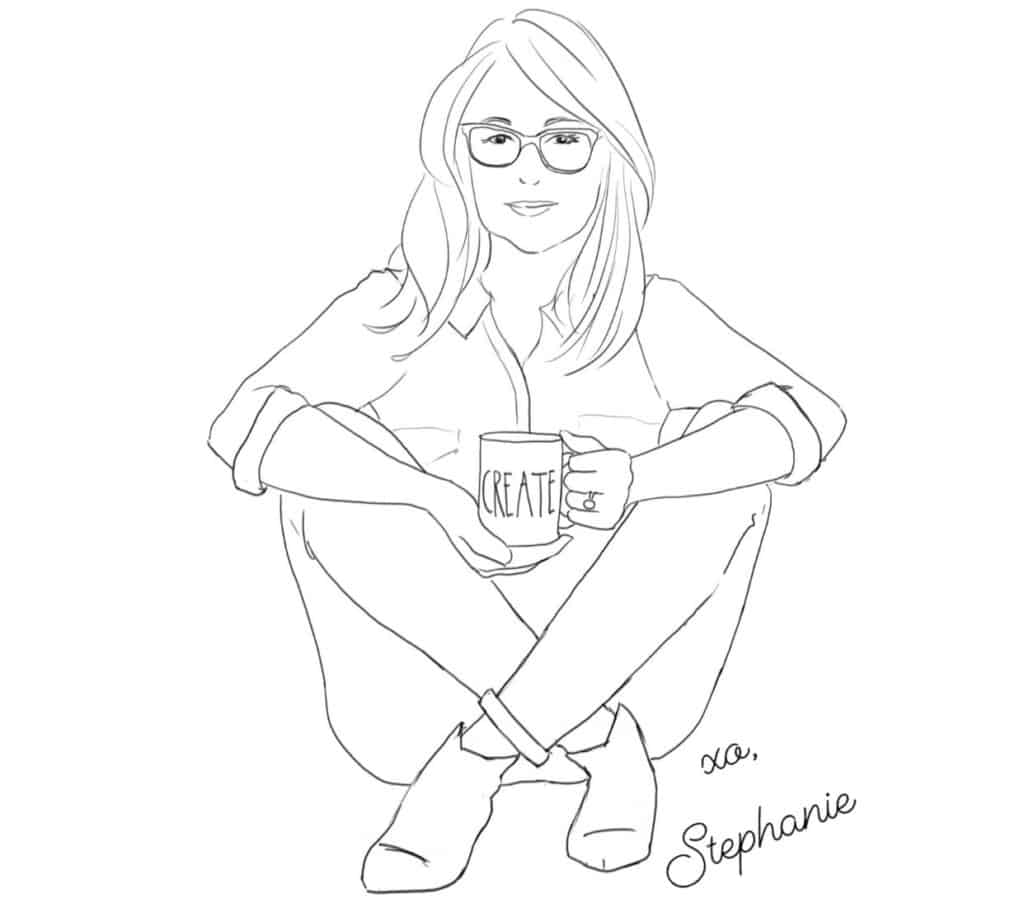




Since Kerrigan pods have a natural hole built in from the brewing process, can’t you just soak/steep the pod(s) and get similar results? Maybe steep a little longer or use multiple pods. Then pitch the whole thing without having the mess of opening them and later straining?
Great point and Im sure that method would work as well! Thank you for visiting the blog!
I have saved and dried coffee grounds for some time by adding them to potting soil. Now I’m going to use the grounds to water and water my house plants.
Awesome! Your plants will love it!
Can I use the flavored coffee grounds, such as French vanilla for one or will something in those harm the plants?
Hi There, The jury is still out on this! Some experts say no some say it's fine. The concerns is around fake flavoring and whether it may be harmful to plants. If you only drink flavored coffee (and I can understand this!) I suggest proceeding cautiously, perhaps dilute it a bit more and see how they respond. Thank you for visiting the blog, please let me know if you have any other questions and if you try the flavored coffee, please circle back!
Stephanie:
Thank you for the great information on using ground coffee as a fertilizer for indoor plants.
I will definitely try this trick. I have 2 African violet plants that do not flower - I will update you once I get a chance to do this for my plants. I'm moving in August so it will be in September once I get settled into my new apt.
Simone
Good luck! I've been working on getting my African violets to bloom again too!
Violets love pine needles!
I had no idea!Thank you!